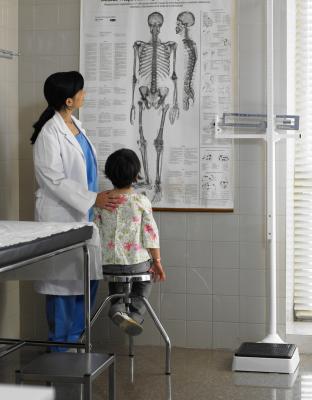Some bone disorders in children are due to rare conditions and require careful clinical evaluation. If not treated promptly, bone disease can affect a child’s bone development, lead to multiple fractures and cause bone deformities. In some cases, bone disease in children leads to deterioration of motor development and permanent disability. Frequently, treatment is delayed because symptoms go unnoticed and only become apparent over time.
Rickets
Rickets is a bone disease that most commonly affects children who have low levels of vitamin D caused by poor diet or an inability to absorb vitamin D and calcium. The disease normally occurs during periods of rapid growth when the body needs more calcium for bone development. Rickets softens bones, producing abnormal bone formation. Celiac disease, kidney problems, inflammatory bowel disease and cystic fibrosis can cause rickets in children by interfering with vitamin D absorption.
Fibrous Dysplasia
Fibrous dysplasia is a condition that can affect any bone in the body. A rare bone disease, the disorder is not hereditary and has no known cause. Either a single bone or multiple bones may be affected. Symptoms include pain, brittleness, uneven bone growth and deformity in affected bones. According to the American Academy of Orthopaedic Surgeons, fibrous dysplasia is present before birth, although the condition often is not diagnosed until childhood, adolescence or adulthood. The disease is more likely to cause problems before age 10 if more than one bone is affected. Common sites of the disease include the skull, facial bones, ribs, pelvis, upper arm, thigh and shin.
Osteomyelitis
Osteomyelitis is infection of the bone, usually caused by bacteria or fungus. It can occur at any age. In children, osteomyelitis affects the adjacent ends of large, long bones, the femur and tibia in the legs and the humerus and radius in the arms. The disease can also occur as the result of sepsis, a bacterial infection in the bloodstream that spreads to the bones. This type of the infection is most common in infants and children. Acute osteomyelitis is usually treated successfully with antibiotics if the condition is detected early enough. Treatment of chronic osteomyelitis is more difficult, especially when the infection interferes with a child’s normal bone growth. In some cases, doctors recommend surgery to remove dead bone tissue.
Brittle Bone Disease
Osteogenesis imperfecta, also known as brittle bone disease, is a genetic bone disorder. The disease has eight different types, with varying symptoms. In Type 1, the most common form, the body produces insufficient quantities of collagen, a protein that helps make bones strong. Symptoms of osteogenesis imperfecta include poor muscle tone, slight curvature of the spine, whites of the eyes being blue-gray in color and bones that fracture easily. Some children with the disease experience early loss of hearing. Brittle bone disease has no cure. Treatment focuses on increasing bone strength to prevent fracture and maintain mobility.
Gorham’s Disease
Gorham’s disease, also known as vanishing bone disease, is extremely rare. The disease usually is not diagnosed until a fracture occurs and the bone fails to heal properly. Gorham’s disease can occur at any age, but is most often diagnosed in children and young adults. The disease is characterized by gradual bone loss. Although the course the disease takes is unpredictable, serious complications occur infrequently as the disease tends to remain localized. Generally, the prognosis is good, as Gorham’s disease can go into spontaneous remission. Treatment includes radiation therapy, interferon therapy and surgery, particularly when the disease is more diffuse. Effectiveness of treatment varies from individual to individual.





